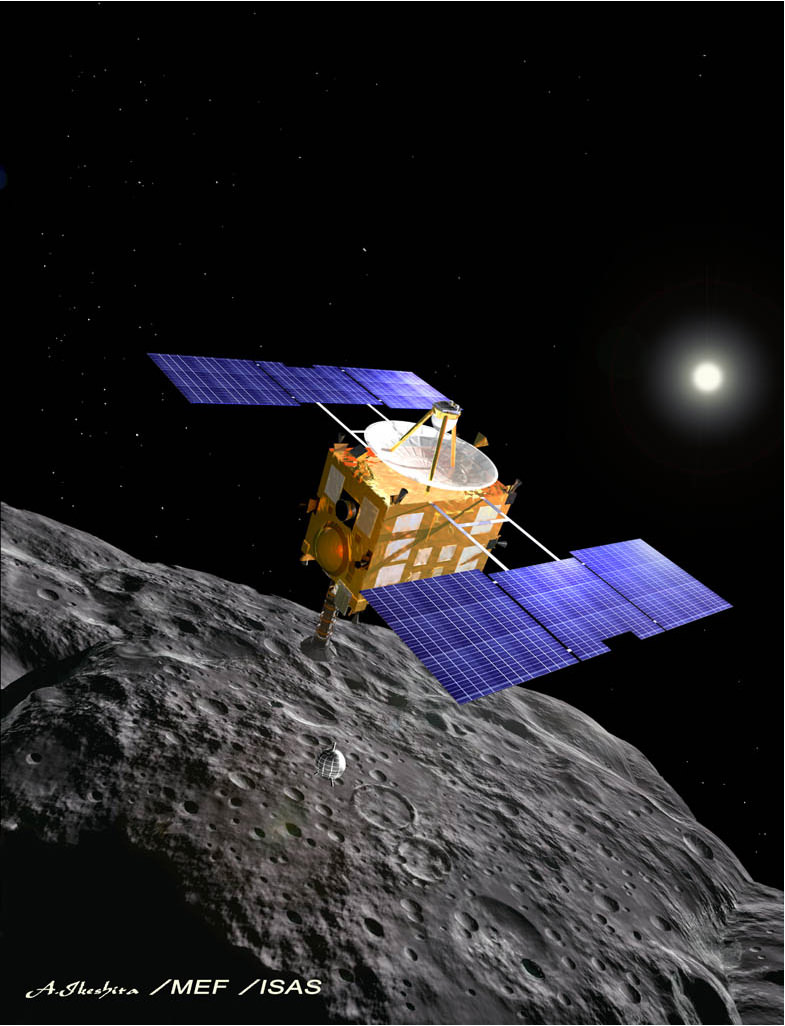[/caption]
A problem-plagued Japanese mission to an asteroid just may have received its final blow. The Haybusa mission, which went to asteroid Itokawa in 2005 is currently trying to return to Earth, but now has suffered a breakdown in the third out of four ion thrusters. The cause was a voltage spike due to problems with a neutralization vessel, which previously caused the failure of two other thrusters. The fourth and only remaining thruster was shutdown earlier by engineers after signs that it also might succumb to high voltage damage. Engineers are now testing that engine, Thruster C, to determine if it is capable of long-duration firings. Hayabusa, which landed on Itokawa (possibly several times – mission managers aren’t sure) might contain samples, but due to a malfunction of the sample collection device, JAXA has acknowledged that it cannot be sure Hayabusa actually managed to take samples from the surface of the asteroid.
Thruster D failed last Wednesday, according to the Japan Aerospace Exploration Agency (JAXA).
Hayabusa’s four experimental microwave discharge ion engines consume xenon gas and expel the ionized propellant at high speeds to produce thrust. Ion engines are more efficient than conventional chemical thrusters because they use less fuel and can operate continuously for thousands of hours. Hayabusa’s thrusters have accumulated almost 40,000 hours of burn time since the probe launched in May 2003.
The spacecraft was originally scheduled to return to Earth in 2007, but the arrival date was pushed back to 2010 following thruster, communications, gyro and fuel-leak problems.
Thruster D had been the lone engine guiding the spacecraft since February 2009. Officials now say they are evaluating the asteroid mission’s return course after last week’s glitch, and will try to re-fire Thruster C in order to obtain the trajectory and speed required for the return to Earth.
Hayabusa spent three months exploring Itokawa in late 2005, taking over 1,600 pictures and collecting near-infrared and X-ray spectral data to investigate the small potato-shaped asteroid’s surface composition.
During a failed sampling attempt in November 2005, Hayabusa made an unplanned landing and spent up to a half-hour on Itokawa, becoming the first spacecraft to take off from an asteroid. The spacecraft attempted to fire a pellet into the asteroid’s surface and retrieve rock samples through a funnel leading to a collection chamber. However, telemetry showed Hayabusa likely did not fire its projectile while on the surface; but scientists were hopeful bits of dust or pebbles found their way through the funnel and into the sample retrieval system.
Source: Spaceflightnow


Man, as they say “If this thing didn’t have bad luck it’d have no luck.” Hope the engineers can find a workaround for this troubled probe.
So frustrating!
That’s sad to hear. This really cool mission has just been plagued with problems. There’s a really, really cool video animation about 30min. long about Hayabusa on Jaxa’s site:
http://spaceinfo.jaxa.jp/inori/en/index.html
~Nick
It was a cool mission but you have to wonder WHY and how so much could go wrong with a single mission… Three out of four thrusters is bad enough, but everything went wrong except the launch (I think?)
I’ve always hated the ion thrusters form of propulsion and I hope this makes NASA stop thinking about using that crap system and spend the money on a system much more reliable and MANY times faster.
We have to get over the fear of nuclear power and fast!